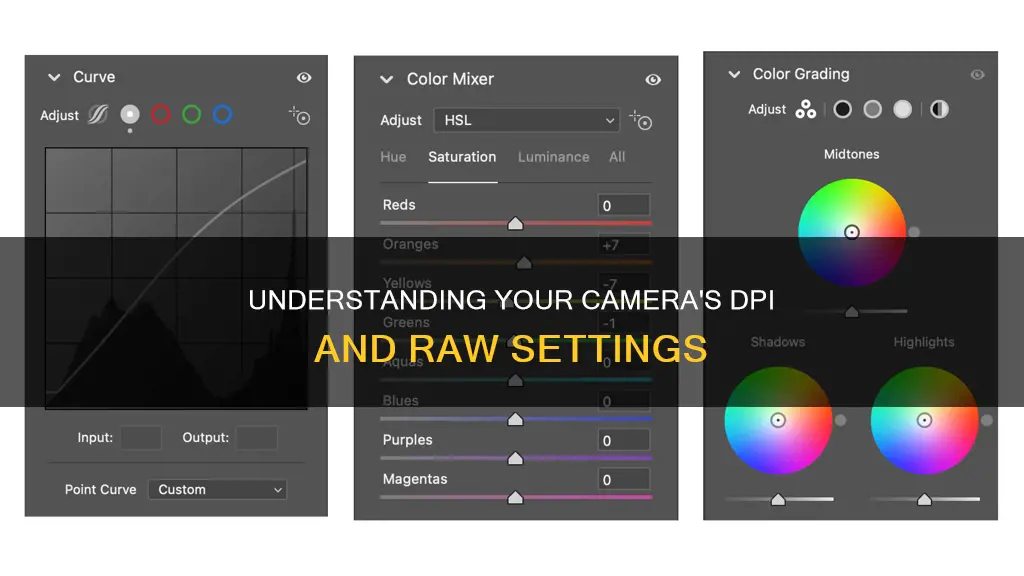
A camera's resolution is measured in pixels, not dots per inch (DPI). DPI is a term that refers to printing and is only relevant to printed images. However, there are several factors that determine a camera's ability to produce high-quality images for printing at 300 DPI, such as pixel count, sensor size, ISO settings, and resolution settings.
When it comes to printing, the number of pixels in an image is more important than the DPI. A higher pixel count allows for larger prints at 300 DPI. Additionally, a larger light sensor captures more information, resulting in higher-quality images. It is also recommended to use the lowest ISO setting possible to avoid grainy images with less usable pixel information.
While cameras do not have DPI settings, you can adjust the DPI of your images after uploading them to a computer. For printing, it is common to set the DPI to 300, as this is the standard for high-quality prints.
| Characteristics | Values |
|---|---|
| DPI meaning | Dots per inch |
| DPI relevance | Refers to printing |
| Camera DPI settings | None |
| High-quality printing factors | High pixel count, large light sensor, high-resolution settings, low ISO |
| DPI adjustability | After uploading images to a computer |
| RAW resolution | 75 dpi |
| JPEG resolution | 300 dpi |
| DPI in Photoshop | Adjustable |
What You'll Learn

DPI is a meaningless metric without knowing the print size
When it comes to digital images, the dots per inch (DPI) metric is often misunderstood as a measure of resolution. However, this notion is misleading and incorrect. The resolution of a digital image is determined by its pixel count, not the DPI value. In other words, DPI is meaningless without specifying the print size.
DPI refers to the physical dot density of an image when it is reproduced onto a physical surface, such as paper. It indicates how many individual dots can be placed within a linear inch. For instance, a printer with a higher DPI typically produces clearer and more detailed output. However, the DPI value alone does not define the quality of the output; it depends on various factors, including the print mode and driver settings.
The confusion arises because DPI is often embedded in image files by cameras, leading people to believe it is a measure of image quality. However, this DPI value is irrelevant when it comes to digital images displayed on screens or even when printing them. The only time DPI becomes relevant is when determining the physical print size of an image while ensuring a certain level of quality.
To illustrate this concept, consider the following: if you have an image that is 3000 pixels wide, you can print it at 10 inches wide with a DPI of 300. Alternatively, you could print the same image at 20 inches wide with a DPI of 150 or 5 inches wide with a DPI of 600. The DPI value is simply the result of dividing the pixel count by the print size.
When preparing a layout for printing, it is crucial to determine the desired print size in inches and ensure the image resolution meets the 300 DPI criterion. While smartphone images are typically high-resolution and suitable for printing, images downloaded from the internet may not meet the 300 DPI requirement. In such cases, either the image size or the layout dimensions may need adjustment to achieve the desired DPI.
In summary, DPI is a metric that relates to the physical reproduction of an image and is calculated by dividing the pixel count by the print size. It is essential to understand that DPI is meaningless without specifying the print size, as the two values are intrinsically linked.
Outdoor Wi-Fi Camera Battery Life: How Long Does It Last?
You may want to see also

Use a camera with a high pixel count
A camera with a high pixel count is essential for capturing images with fine details and ensuring that the quality remains intact even after post-production modifications such as cropping and removing objects.
The resolution of a digital image is determined by its pixel count, not the embedded ppi/dpi number. A higher pixel count allows for larger prints without a noticeable loss in quality. For example, a 50-megapixel camera can produce a 32" x 48" print, while a 24-megapixel camera can handle 12" x 18" or 16" x 24" prints with ease.
When it comes to specific applications, high-megapixel cameras are ideal for professional photography, filmmaking, drone photography, and product photography. In these fields, capturing intricate details and maintaining image quality during post-production are crucial.
Additionally, high-megapixel cameras are useful when large prints are required. With a higher pixel count, the enhancement in size is less visible to the naked eye, resulting in sharper and more detailed images.
It is worth noting that while megapixels are important, they are not the only factor influencing image quality. Other aspects such as sensor size and type, lens quality, file format, and ISO settings also play a significant role in determining the overall image quality.
Charging the Noorio Camera: A Quick Guide
You may want to see also

Choose a camera with a large light sensor
When it comes to digital cameras, there are three standard sensor sizes: full-frame, APS-C, and Four Thirds. Full-frame sensors are the largest, followed by APS-C, and then Four Thirds. A larger sensor will generally produce higher-quality images, as it can gather more light and details, resulting in clearer and less noisy pictures. This is especially beneficial when shooting in low-light conditions or when aiming for a shallow depth of field.
Full-frame sensors, measuring 36 x 24mm, are typically found in professional-level DSLRs and mirrorless cameras, as well as some high-end compact cameras. They offer the best image quality and are suitable for serious enthusiasts and portraiture professionals. However, they tend to be more expensive and are physically larger, making them less portable.
APS-C sensors, which are commonly found in entry-level to mid-level DSLRs, mirrorless cameras, and high-end compact cameras, measure around 22 x 15mm to 24 x 16mm. While slightly smaller than full-frame sensors, APS-C sensors still offer excellent image quality and are capable of capturing a wide range of shots, from portraiture to sports and landscapes. Cameras with these sensors are generally smaller, lighter, and more affordable, making them a good choice for dedicated photography hobbyists.
Four Thirds sensors, measuring 18 x 13.5mm, are typically found in Micro Four Thirds cameras made by Olympus and Panasonic. These cameras are ideal for casual photographers, beginners, or those who prioritise a small and lightweight setup, such as backpackers and trekkers. While the image quality may not be as high as larger sensors, modern sensor technology has improved low-light performance, and the smaller sensor size allows for more compact and affordable lenses.
When choosing a camera with a large light sensor, consider your budget, the physical size and weight of the camera, and your photography needs. Full-frame sensors offer the best low-light performance and background blur but come at a higher cost. APS-C sensors provide a balance between image quality and portability, while Four Thirds sensors are the most compact and budget-friendly option.
Loading Batteries into Your DXG 552 Camera: A Step-by-Step Guide
You may want to see also

Set the camera to the highest resolution settings possible
Setting your camera to the highest resolution possible is a great way to ensure that you get the best quality photos. Here are some tips to help you do that:
- Find the "quality" or ""resolution" settings in your camera's menu and set the resolution to the highest value. Most DSLR cameras won't list the resolution in megapixels, but instead use a series of icons indicating different qualities or sizes. Always choose the largest size or number available.
- If your camera offers multiple versions of each size, opt for the curved icon over the stair-step icon, as this indicates better quality compression, resulting in a higher-resolution photo.
- Shoot in RAW if you plan on doing any editing. While JPEG is the more popular file type, your camera may drop some quality if you shoot in this format. Shooting in RAW ensures you get the most accurate image possible, and you can always transfer it to JPEG later without losing pixels.
- Use the lowest ISO available given the lighting conditions. A lower ISO will help maintain the texture and smoothness of your images, preserving the integrity of the resolution.
- When you need to zoom in on a subject, use your lens instead of digital zoom. Digital zoom artificially enlarges your pixels, lowering the overall resolution of the image.
- If you're using a phone, you may not need to adjust any settings, as most phones automatically shoot in high resolution. However, you can change the video resolution on an iPhone by going into the camera app and tapping the FPS icon in the corner of the viewfinder.
- For Android phones, you can usually adjust the photo resolution in the camera's settings menu. Select the highest number available to shoot in the highest resolution.
By following these tips, you can ensure that you're capturing the highest-resolution images possible with your camera or phone.
Bayit Outdoor Camera: Is It Battery-Powered?
You may want to see also

Use as low of an ISO as possible for the lighting conditions
ISO refers to how sensitive your camera's sensor is to light. A lower ISO value means less sensitivity to light, while a higher ISO means more sensitivity. It is one of the three pillars of photography, alongside aperture and shutter speed, and plays a critical role in the quality of your photos.
A low ISO value, such as 300 and lower, generally results in a higher-quality photo. Bright conditions, like shooting outdoors on a sunny day, benefit from lower values. Landscape photography, for instance, is well-suited to low ISO values as they prevent photos from looking overly exposed or washed out.
A low ISO is also advantageous when you want to achieve a specific effect, such as freezing action with a fast shutter speed or creating a shallow depth of field with a wider aperture. In these cases, a low ISO helps to avoid overexposure and maintains image sharpness.
Additionally, using a low ISO setting will result in better technical quality photos. There will be little to no digital noise, and colours and contrast in your images will be improved. This is because higher ISO values can introduce "noise" or graininess into your photos, degrading image quality.
Therefore, it is generally recommended to use as low of an ISO as possible for the lighting conditions. This will ensure you capture the highest quality images with optimal sharpness, dynamic range, and minimal noise.
Shipping Camera with Battery: Europe-Specific Guide
You may want to see also
Frequently asked questions
It isn't. DPI is a meaningless metric when it comes to cameras and photography. The resolution of a digital image is indicated by its pixel count, not its embedded ppi/dpi number.
On professional cameras, the "RAW" setting captures the most data in an uncompressed form.
Use a camera that has a high pixel count. The bigger the light sensor, the more information it captures. Set the camera to the highest resolution settings possible.







